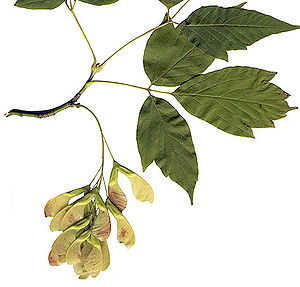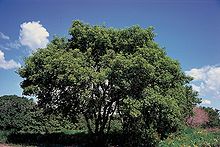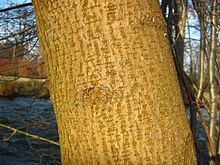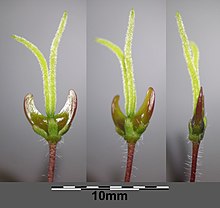Ash maple
| Ash maple | ||||||||||||
|---|---|---|---|---|---|---|---|---|---|---|---|---|

Ash maple ( acer negundo ) |
||||||||||||
| Systematics | ||||||||||||
|
||||||||||||
| Scientific name | ||||||||||||
| Acer negundo | ||||||||||||
| L. |
The Acer negundo , also called Eschenblättriger maple ( Acer negundo ) is a plant from the genus of maple ( Acer) in the family of soap tree plants (Sapindaceae).
description

Vegetative characteristics
The ash maple is a deciduous tree that can grow to heights of up to 15 meters and trunk diameters of around 0.5 meters. The bark is smooth and gray-brown, more dark gray with age, but mostly greenish due to algae growth. The tree crown is irregularly arched; inside it is condensed by many water veins on the trunk and branches; old trunks are often leaned over to prostrate. The bark of the straight branches is green and sometimes with violet frosting in the second year. The small bud is silky white.
The constantly against arranged on the branches leaves are divided into petiole and leaf blade. The imparipinnate leaf blade contains three to seven pinnate leaves . If there are only three leaflets, then the middle one is three-lobed and significantly larger than the two lateral ones. The entire leaf is up to 20 centimeters long and about 15 centimeters wide. The lowest pair of plumage sits on a 1 to 2 centimeter long stalk, the upper pair sits directly on it. The individual leaflets are 5 to 10 centimeters in length and have a pointed upper end and a few large teeth. The leaflets are very thin and light green above; below they are lighter and often thinly haired.
Generative characteristics
The ash-maple is dioecious separately sexed ( dioecious ). The male flowers sit in thin, hanging clusters and turn yellow in early March (well before the leaves shoot). The female flowers sit in even longer pendulous racemose inflorescences .
The approximately 4 centimeters long fruits are yellow-white with acute-angled, inwardly curved wings; they ripen early; Without a male tree in the vicinity, however, they are usually "deaf", i.e. not fertilized and therefore not capable of germination.
The number of chromosomes is 2n = 26.
ecology
The ash maple is as insensitive to smoke and dust in urban areas as it is to drought. However, with age the tree becomes brittle in the crown and is therefore at risk of wind breakage.
The pollination is carried by the wind ( Anemogamie )

distribution
The ash maple is native to eastern North America from Ontario to Florida with geographical varieties as far as Alberta , California and Texas . It thrives there in the East American alluvial forests of the order Ulmo-Aceretalia-saccharini and in California in those of the order Platanetalia-racemosi.
The ash maple was introduced to Central Europe as early as 1688 and is still one of the most widely planted foreign trees. He is naturalized as a neophyte . It thrives occasionally in Central Europe in riparian forests in Querco-Ulmetum from the Association Alno Ulmion.
Systematics
The first publication of Acer negundo was by Carl von Linné .
There are several varieties of Acer negundo , including:
- Acer negundo L. var. Negundo
- Acer negundo var. Californicum ( Torr. & A.Gray ) coffin. : This variety is only native to Southern California . The bark of the twigs is tomentose; There are usually exactly three leaflets per leaf, which are permanently hairy on the underside.
Cultivated forms
Several varieties were selected, including with variegated leaves:
- 'Auratum': This variety has partly yellow foliage; In contrast to the 'Odessanum' variety, the bark of young twigs is hairless. This variety is nowhere near as beautiful as 'Odessanum' and therefore practically no longer in cultivation. Only specimens of 'Odessanum' in the trade are often incorrectly referred to as 'Auratum'.
- 'Aureo-Variegatum': This variety, also called golden ash maple, has yellow-green foliage. The variety is male.
- 'Flamingo': This variety, also known as the flamingo ash maple, has white-pink-green foliage. This strain is female.
- 'Odessanum': This cultivated form originated in Odessa in 1891 . The bark of young twigs is densely hairy whitish; the leaves are bright golden yellow when the sun is shining. More common in parks and gardens.
- 'Variegatum': This variety originated in France in 1852 is also called silver ash maple. It is the most commonly planted variegated form and can be found everywhere in gardens and parks. It is relatively weak and has frosted shoots. The leaflets are broad and have a very irregular white border; in the middle they are green with interspersed white fields. Young leaves have pink margins. The fruits sit in slender, 10 centimeter long clusters of five fruits each. The fruits have light green wings that are shaded yellowish and pink.
- Acer negundo var. Californicum 'Violaceum': This vigorous form has a brown-green bare bark, which later becomes almost purple-black and is frosted blue. The leaves are dark green and softly hairy below; the petioles are red.
Individual evidence
- ↑ a b c Erich Oberdorfer : Plant-sociological excursion flora for Germany and neighboring areas . With the collaboration of Angelika Schwabe and Theo Müller. 8th, heavily revised and expanded edition. Eugen Ulmer, Stuttgart (Hohenheim) 2001, ISBN 3-8001-3131-5 , pp. 646 .
- ↑ Acer negundo L., ash maple. In: FloraWeb.de.
literature
- Helmut Pirc: Trees from AZ , Eugen Ulmer GmbH, Stuttgart 2004, ISBN 3-8001-4577-4 .
Web links
- Profile and distribution map for Bavaria . In: Botanical Information Hub of Bavaria .
- Acer negundo L. In: Info Flora , the national data and information center for Swiss flora . Retrieved December 5, 2015.
- Thomas Meyer: Data sheet with identification key and photos at Flora-de: Flora von Deutschland (old name of the website: Flowers in Swabia ).
- Data sheet for portraits of important invasive and potentially invasive vascular plants In: Neobiota des BfN.
- Ash-maple identification aid. (PDF; 0.3 MB)






